The Intel SSD 710 (200GB) Review
by Anand Lal Shimpi on September 30, 2011 8:53 PM EST- Posted in
- Storage
- SSDs
- Intel
- Intel SSD 710
AnandTech Storage Bench 2011
Last year we introduced our AnandTech Storage Bench, a suite of benchmarks that took traces of real OS/application usage and played them back in a repeatable manner. I assembled the traces myself out of frustration with the majority of what we have today in terms of SSD benchmarks.
Although the AnandTech Storage Bench tests did a good job of characterizing SSD performance, they weren't stressful enough. All of the tests performed less than 10GB of reads/writes and typically involved only 4GB of writes specifically. That's not even enough exceed the spare area on most SSDs. Most canned SSD benchmarks don't even come close to writing a single gigabyte of data, but that doesn't mean that simply writing 4GB is acceptable.
Originally I kept the benchmarks short enough that they wouldn't be a burden to run (~30 minutes) but long enough that they were representative of what a power user might do with their system.
Not too long ago I tweeted that I had created what I referred to as the Mother of All SSD Benchmarks (MOASB). Rather than only writing 4GB of data to the drive, this benchmark writes 106.32GB. It's the load you'd put on a drive after nearly two weeks of constant usage. And it takes a *long* time to run.
1) The MOASB, officially called AnandTech Storage Bench 2011 - Heavy Workload, mainly focuses on the times when your I/O activity is the highest. There is a lot of downloading and application installing that happens during the course of this test. My thinking was that it's during application installs, file copies, downloading and multitasking with all of this that you can really notice performance differences between drives.
2) I tried to cover as many bases as possible with the software I incorporated into this test. There's a lot of photo editing in Photoshop, HTML editing in Dreamweaver, web browsing, game playing/level loading (Starcraft II & WoW are both a part of the test) as well as general use stuff (application installing, virus scanning). I included a large amount of email downloading, document creation and editing as well. To top it all off I even use Visual Studio 2008 to build Chromium during the test.
The test has 2,168,893 read operations and 1,783,447 write operations. The IO breakdown is as follows:
| AnandTech Storage Bench 2011 - Heavy Workload IO Breakdown | ||||
| IO Size | % of Total | |||
| 4KB | 28% | |||
| 16KB | 10% | |||
| 32KB | 10% | |||
| 64KB | 4% | |||
Only 42% of all operations are sequential, the rest range from pseudo to fully random (with most falling in the pseudo-random category). Average queue depth is 4.625 IOs, with 59% of operations taking place in an IO queue of 1.
Many of you have asked for a better way to really characterize performance. Simply looking at IOPS doesn't really say much. As a result I'm going to be presenting Storage Bench 2011 data in a slightly different way. We'll have performance represented as Average MB/s, with higher numbers being better. At the same time I'll be reporting how long the SSD was busy while running this test. These disk busy graphs will show you exactly how much time was shaved off by using a faster drive vs. a slower one during the course of this test. Finally, I will also break out performance into reads, writes and combined. The reason I do this is to help balance out the fact that this test is unusually write intensive, which can often hide the benefits of a drive with good read performance.
There's also a new light workload for 2011. This is a far more reasonable, typical every day use case benchmark. Lots of web browsing, photo editing (but with a greater focus on photo consumption), video playback as well as some application installs and gaming. This test isn't nearly as write intensive as the MOASB but it's still multiple times more write intensive than what we were running last year.
As always I don't believe that these two benchmarks alone are enough to characterize the performance of a drive, but hopefully along with the rest of our tests they will help provide a better idea.
The testbed for Storage Bench 2011 has changed as well. We're now using a Sandy Bridge platform with full 6Gbps support for these tests. All of the older tests are still run on our X58 platform.
AnandTech Storage Bench 2011 - Heavy Workload
We'll start out by looking at average data rate throughout our new heavy workload test:
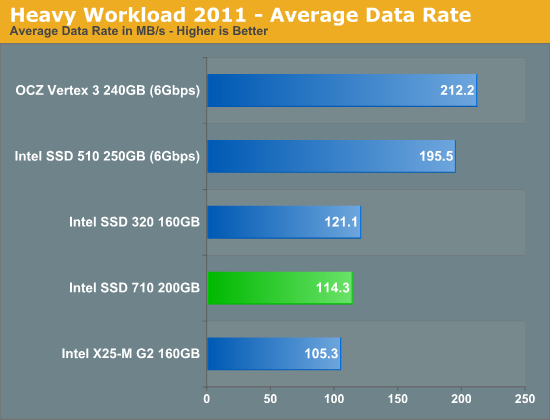
I threw in our standard desktop tests just to hammer home the point that the 710 simply shouldn't be used for client computing. Not only is MLC-HET overkill for client workloads, but the Intel SSD 320's firmware is better optimized for client computing.
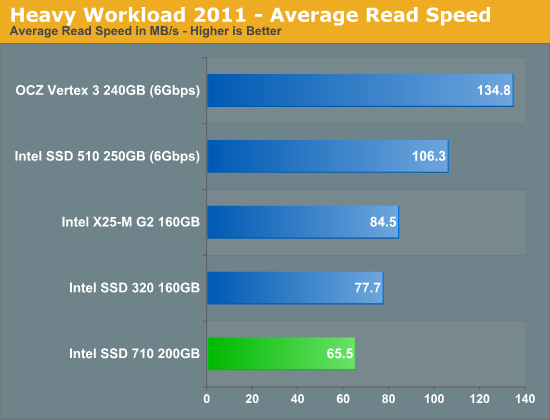
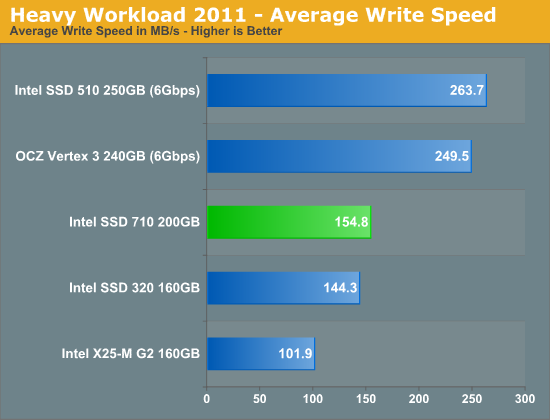
The next three charts just represent the same data, but in a different manner. Instead of looking at average data rate, we're looking at how long the disk was busy for during this entire test. Note that disk busy time excludes any and all idles, this is just how long the SSD was busy doing something:
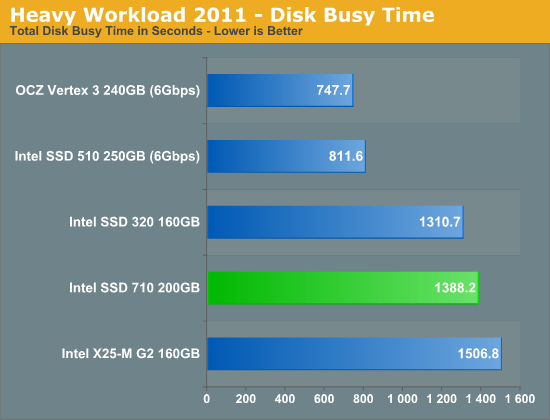
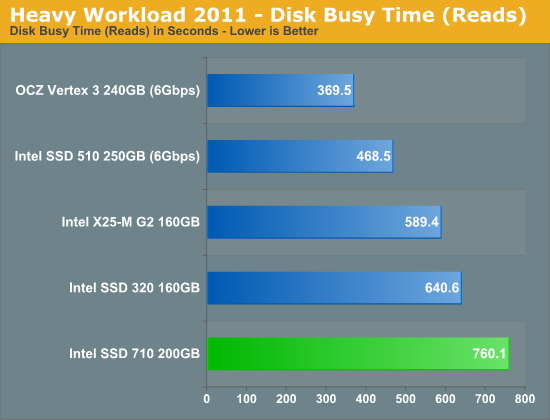
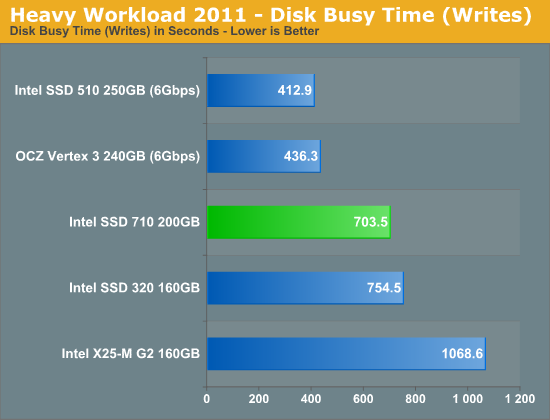










68 Comments
View All Comments
cdillon - Friday, September 30, 2011 - link
I must be missing some important detail behind their decision to use MLC. MLC holds exactly twice as much information per cell as SLC, which means you can get twice the storage with the same number of chips. However, they are reserving up to 60% of the MLC NAND as spare area while still achieving a LOWER write-life than the SLC-based X25-E which only needs 20% spare. Why not continue to use lower-density SLC with a smaller spare area? The total capacity would only be slightly lower while achieving at least another 500GB of write life, if not more, and would probably also bring the 4KB Random Write numbers back up to X25-E levels.cdillon - Friday, September 30, 2011 - link
Oops, I meant to say "at least another 500TB of write life" instead of 500GB.Stahn Aileron - Saturday, October 1, 2011 - link
More than likely it has to do with production yields. Anand mentions SLC and MLC are physically identical, it's just how you address them. SLC seems to be very high quality NAND while MLC is the low end. MLC-HET (or eMLC) seems to be the middle of the pack in terms of overall quality.Unless you can get SLC yields that consistently outpace MLC-HET yields by a factor of 2, it's not very economical in the long run for the same capacity.
Also, chip manufacturing is a pretty fixed cost at the wafer level from my understanding (at least once you hit mass production on a mature process). For SLC vs MLC, you can either use double the SLC chips to match MLC capacities (higher cost) or use the same number of chips and sacrifice capacity. Intel seems to be trying to get the best of both worlds (higher capacity at the same or lower costs). (All that while maximizing their production capacity and ability to meet demand as needed as a side benefit.)
Obviously I could be wrong. That's all conjecture based on what little I know of the industry as a consumer.
ckryan - Friday, September 30, 2011 - link
Anand, thanks for the awesome Intel SMART data tip.I've joined in the XtremeSystems SSD endurance test. By writing a simulated desktop workload to the drive over and over, for months on end, eventually a drive will become read only. So far, only one drive has become RO, and that was a Samsung 470 with an apparent write amplification of 5+(this was the only SSD I've ever heard of that this has happened to outside of a lab). Another drive (a 64GB Crucial M4) has gone through almost 10,000 PE cycles, and still doesn't have any reallocated sectors -- but all of the drives have performed well, and many have hundreds of TBs on them. I chose a SF 2281 with Toshiba toggle NAND, but I'm having some issues with it (like it won't stop dropping out/or BSOD if it's the system drive). Though it takes months and months of 24/7 writing, I think the process is both interesting and likely to put many users at ease concerning drive longevity. I don't think consumers should be worrying about the endurance of 25nm NAND, but I do start wondering what will happen with the advent of next generation flash. If you want to worry about NAND, worry about sync vs async or toggle, but don't sweat the conservative PE ratings -- it seems like the controller itself plays a super important role in the preservation of NAND in addition to the NAND itself and spare area. Obviously, increasing spare area is always a good idea if you have a particularly brutal workload, but it's not a terrible idea in many other settings... it's not just for RAID0 you know.
The only real SSD endurance test takes place in a user's machine (or server), and I have no doubts that any modern SSD will last anything less than the better part of a decade -- at least as far as the flash is concerned (and probably much, much longer). You'll get mad at your SF's BSoDs and throw it out the window before you ever make a dent in the flash's lifespan. The only exception is if your drive isn't aligned (and especially without trim). Under these conditions don't expect your drive to last very long as WA jumps by double digit factors.
http://www.xtremesystems.org/forums/showthread.php...
Movieman420 - Friday, September 30, 2011 - link
Yup. And you can expect the current SF bsod problem to vanish when intel fixes it's drivers and oroms. What coincidence eh?http://thessdreview.com/latest-buzz/sandforce-driv...
JarredWalton - Saturday, October 1, 2011 - link
Ha! An educated guess in this case feels more like a pipe dream. If Intel is willing to jump on the SF controller bandwagon, I will be amazed. Then again, they've got the 510 using a non-Intel controller, so anything is possible.ckryan - Saturday, October 1, 2011 - link
It kinda makes sense though. Intel using a Sandforce controller (or possibly "Sandforce-eque") but with their firmware and NAND would be tough to stop. The SF controller (when it works -- In my case not always that often) yields benefits to consumer and enterprise workloads alike. Further, it could help bridge Intel into smaller process NAND with about the same overall TBW due to compression (My 60GB has about 85TB host to ~65TB nand writes). That's not a small amount over the lifespan of a drive. Along with additional overprovisioning, Intel could conceivably make a drive with sub-25nm NAND last as long as the 34nm stuff with those two advantages.There's nothing really stopping SF now except for the not-so little stability issues. I thought it was much rarer that it actually is (it's rare when it happens to someone else and an epidemic when it happens to you). With that heinous hose-beast no longer lurking in the closet, SandForce could end up being the only contender. Until such time as they get the problems resolved, whether or not you have problems is just a crapshoot... no seeming rhyme or reason, almost -- but not quite -- completely random. If Intel could bring that missing link to SF it would be a boon to consumers, but Intel could just as well buy SandForce to get rid of them. Either is just as likely, and conspiracy theorists would say that Intel is purposely causing issues with SF drives so they don't have to buy them (or don't have to pay as much). In the end, most consumers would just be happy if the 2281 powered drives they already have worked like the drive it was always mean to be.
Movieman420 - Saturday, October 1, 2011 - link
Guess you didn't follow the story over to VR Zone either. It's a done deal. Cherryville is SandForce 2200. It should be announced before long imo.rishidev - Friday, September 30, 2011 - link
Why even bother to make a 200gb drive at this point of time.AMD fanboys get abused for masturbating .
So What ?? im supposed to buy a $1300 Intel ""WOOOW" ssd drive.
TheSSDReview - Saturday, October 1, 2011 - link
Because Intel wants to hit the enthusiast market. The new drives wont be anywhere near the price of these 710 series drives and will demand product confidence as Intel has always had such. It is a win-win for SF since many have taken comfort in speculation of controller troubles rather than examining other such causes.The question then becomes one of SF purchase we think.